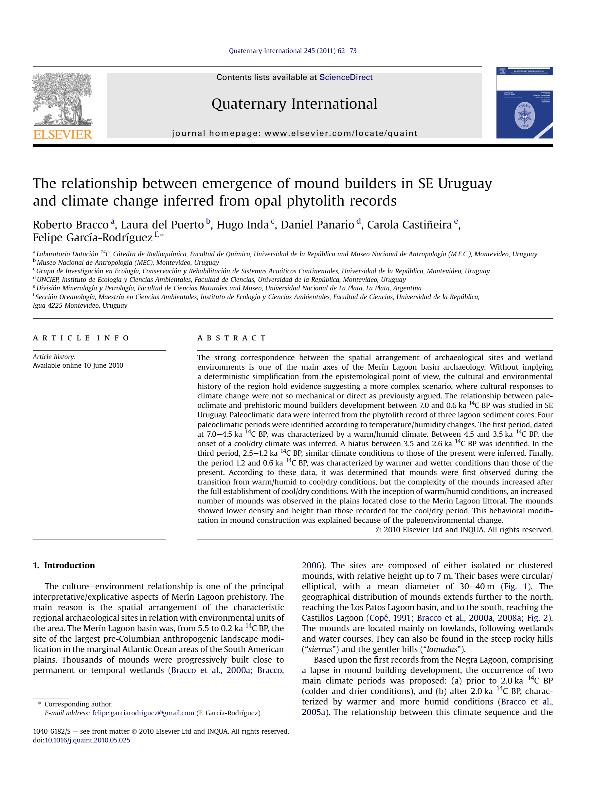Artículo
The relationship between emergence of mound builders in SE Uruguay and climate change inferred from opal phytolith records
Bracco, Roberto; del Puerto, Laura; Inda, Hugo; Panario, Daniel; Castiñeira Latorre, Carola ; Garcia Rodriguez, Felipe
; Garcia Rodriguez, Felipe
 ; Garcia Rodriguez, Felipe
; Garcia Rodriguez, Felipe
Fecha de publicación:
11/2011
Editorial:
Pergamon-Elsevier Science Ltd
Revista:
Quaternary International
ISSN:
1040-6182
Idioma:
Inglés
Tipo de recurso:
Artículo publicado
Clasificación temática:
Resumen
The strong correspondence between the spatial arrangement of archaeological sites and wetland environments is one of the main axes of the Merín Lagoon basin archaeology. Without implying a deterministic simplification from the epistemological point of view, the cultural and environmental history of the region hold evidence suggesting a more complex scenario, where cultural responses to climate change were not so mechanical or direct as previously argued. The relationship between paleoclimate and prehistoric mound builders development between 7.0 and 0.6ka 14C BP was studied in SE Uruguay. Paleoclimatic data were inferred from the phytolith record of three lagoon sediment cores. Four paleoclimatic periods were identified according to temperature/humidity changes. The first period, dated at 7.0-4.5ka 14C BP, was characterized by a warm/humid climate. Between 4.5 and 3.5ka 14C BP, the onset of a cool/dry climate was inferred. A hiatus between 3.5 and 2.6ka 14C BP was identified. In the third period, 2.5-1.2ka 14C BP, similar climate conditions to those of the present were inferred. Finally, the period 1.2 and 0.6ka 14C BP, was characterized by warmer and wetter conditions than those of the present. According to these data, it was determined that mounds were first observed during the transition from warm/humid to cool/dry conditions, but the complexity of the mounds increased after the full establishment of cool/dry conditions. With the inception of warm/humid conditions, an increased number of mounds was observed in the plains located close to the Merín Lagoon littoral. The mounds showed lower density and height than those recorded for the cool/dry period. This behavioral modification in mound construction was explained because of the paleoenvironmental change.
Palabras clave:
Mound
,
Phytolith
,
Paleoclimate
,
Uruguay
Archivos asociados
Licencia
Identificadores
Colecciones
Articulos(CCT - LA PLATA)
Articulos de CTRO.CIENTIFICO TECNOL.CONICET - LA PLATA
Articulos de CTRO.CIENTIFICO TECNOL.CONICET - LA PLATA
Citación
Bracco, Roberto; del Puerto, Laura; Inda, Hugo; Panario, Daniel; Castiñeira Latorre, Carola; et al.; The relationship between emergence of mound builders in SE Uruguay and climate change inferred from opal phytolith records; Pergamon-Elsevier Science Ltd; Quaternary International; 245; 1; 11-2011; 62-73
Compartir
Altmétricas



